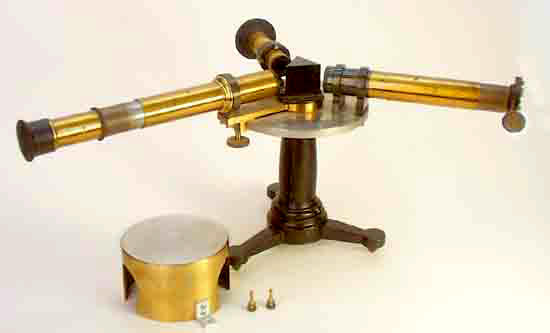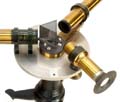No Words are
Powerful Enough To Express The Importance Of Basic Scientific
Research To Our Past, Present, And Future.
Click here for more
information
HISTORICAL INSTRUMENTS OF SCIENCE & TECHNOLOGY FOR SALE & FOR PROPS
9 Morningside Rd. Wakefield Ma. 01880 ---call 781 245 2897
To Email Us For Availability and Prices
k1ugm@comcast.net |
For Sale a symbolic Spectroscope of the type used in
Edison's development of the light bulb.

A beautiful Prism Spectroscope
of late1800's
 |
Thumbnail at your left shows the reminisce
of the base and collimator of
Thomas Edison's
spectroscope in his laboratory
where he used it to invent his light bulb and other inventions.
Our photo above is one of
the same type and manufacture. and fully operational. |
This fine spectroscope is a
prism type, giving a brilliant spectrum of ample length and sharpness
suitable for the use in becoming familiar with the solar spectrum for
observing and charting flame spectra, and analyzing gems from their
absorption spectra.
The collimator and the telescope objectives have an 18 mm aperture and a
focal length of about 200 mm. The telescope has focal adjustment and rotates
about the prism axis to permit setting on any part of the spectrum. The
scale for measuring wavelengths is mounted on a draw tube to permit
adjustment to the focus of the telescope. It is a photographic negative
having 22 figured divisions each divided to tenths. The two sodium lines are
just resolved in this spectroscope. The prism table cover, for protecting
the prism and lenses from dust, is held onto the table
with knurled brass thumb screws. The slit is adjusted through a spring
linkage to protect the jaws.
The spectroscope stand is a black cast iron base with three legs. The prism
table is aluminum and brass. The telescope, collimator and back lighted
scale tubes are brass gold lacquered . The prism’s back surface is painted
black. The overall condition is very good. Cosmetically it has a few paint
chips and some spotting of the lacquered brass. The unit is unsigned. the
most likely manufacture date is late 1800.
Included are a photograph of the instrument and two engravings showing the
optics and a typical bench setup.
AST ITEM # 463 |
The light from a low pressure electric discharge
tube running at about 1/300 of an atmosphere of air and a few milliamps of
current is shown on the right side of the photo below.
It has a purple to white color when viewed by the unaided eye.
When viewed thru a spectroscope the light is sorted out into a rainbow bar
code such as shown on the left side of the photo.
The colors range from deep blue through yellow green to dark red.
When air is heated, such as by the passage of electric current, some of the
molecules break apart into individual atoms.
Both atoms and the molecules when heated hot enough will give off light with
their own unique bar code of colors.
Since air is a mixture of molecules of , nitrogen, oxygen with traces of
carbon dioxide, water vapor, methane and the rare gases argon thru xenon the
spectrum is quite a complicated set of colored bar codes.
The light from lightning, electric sparks, the northern lights and during
the growth of the fireball of atomic and hydrogen bombs give is not
grossly different than the spectra shown below.
Studying the spectra in the laboratory using spectroscopes has given the
Scientist and engineer an understanding and some times control of the
processes which affect the protection of our power grid, radio communication,
and the design of weapons of mass destruction, metallurgy, forensic analysis
Last but not least spectroscopes and spectroscopy for the most part is the basic
tool with which we have developed understanding our world and universe.
-
Every serious collection of
a technical nature has to include a spectroscope to be
truly complete.
-
For those who are Edison followers they
should have one for their collection.
-
Gem collectors can use them in their analysis of
their jewels.
-
It can be used in a general chemical lab
-
For classes in astronomy
|

On the right are pictures of the spectra and
Scale viewed through this spectroscope for Hydrogen, Water vapor,
Nitrogen, Air and Mercury. The Graph in the lower center is used to convert the
scale readings to wavelength.

Detailed photos of the various parts of a
spectroscope.

Prism Table. |

Telescope Adjustment |

Eye Piece
|

Slit Adjustment |

Wavelength Scale. |

Base |

Relative size |
.Back to Home page
|
A laboratory set up to study the chemical,
electrical, and optical properties of gases


The spectroscope
is one of the most powerful important inventions man has yet
created. Yet it has been totally ignored by almost every man and
woman in the home the street and the laboratory.
Just think what it
represents;
Most every instrument;
on the Hubble, in every observatory, aboard all of our planetary
probes, chemical labs and factories, crime labs, paint stores,
hospitals testing labs, the list goes on and on and on.
|
They
all have and use spectro-
- scopes,
- graphs,
- meters,
- etc.
They have been used to
measure
the chemical
composition of our sun,
the stars
their age
their magnetic fields
electric fields
their velocity ( the
expanding universe)
the presence of
planets around other stars
They have been used
to discover and quantify all of the chemical elements in the period
table. For example they told Madam Curie that radium broke down into
helium etc
Edison
used them to make light bulbs etc.etc
They gave us quantum
mechanics
They have given us
glimpse of how our body and brain works
They gave us high
quality steel sophisticated alloys, plastics, etc.
The list goes on and
on and this is just the tip of what they do for us, to us with every
breath we take.
Are they
important? You Bet. and you can have one of your very own.
|
Return to our
main web site

Copyright 1/11/2005 Jim & Rhoda Morris
Permission Granted with acknowledgement when used for academic purposes.












